Leonardo and nature
Leonardo’s legacy, his notes, drawings, paintings and inventions, all illustrate a unique and special relationship with nature. They also reveal a fascinating picture of his attitude towards man and man’s relationship with the natural world. For Leonardo, man was the supreme achievement of nature, a microcosm that mirrored in its whole and all its parts the macrocosm or greater world. Fascinated with the human body, he planned a treatise on the subject that was breathtaking in terms of its all-encompassing vision. Man in all his infinite complexity would be studied from the womb to full-grown adulthood and old age. In addition to examining all of the inner workings of the human body, the treatise would include a study of the proportions and all the movements of figures, in addition to optics, perspective and even music.
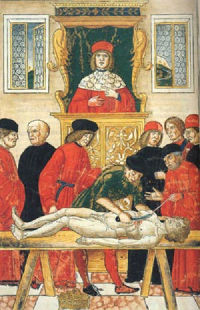
- Illustration of a dissection from the Fasciculo di Medicina, ed by Johannes Ketham, 1493
Anatomy
Dissection for the purpose of medical research had been practised in Italy since the 13th century. However, early anatomical treatises tended to confirm long established views on the workings of the body rather than provide new insights on the basis of observation.In the course of his scientific endeavours, Leonardo claimed to have dissected ten bodies. At the end of his life he increased the number to 30! This does seem unlikely, but he certainly dissected a 100 year-old man, gaining important insights regarding the organs of the body and their functions.
The death of the old man was diagnosed as the result of the silting-up of his veins, much like the deposition of silt by rivers on their banks causing the speed of their flow to slow down.
Leonardo’s anatomical drawings are unprecedented in terms of their accuracy and understanding of how things functioned, foreshadowing the work of Vesalius almost a century later. On one sheet, Leonardo promised that his “depicting of the human body” will be as clear as if “you had the natural man before you”.
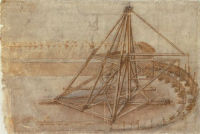
- Codex Atlanticus, Fol 4r - Machine for excavating canals © Biblioteca Ambrosiana - Auth. No Int 40/05
Inventions for man's benefit
Leonardo spent a great deal of time inventing mechanisms for the benefit of man. His labour-saving devices harnessed human motive power, which was still the readiest form of available energy at that time. At times his notebooks read like a mail order catalogue for every sort of tool, gadget or device one could possibly imagine! He addressed the need for standardisation of parts for machines, inventing metal fashioning devices, such as a metal roller for turning out flat tin sheets, which may have been the first in the history of technology.Around 1495, he invented a shearing machine to trim the nap off woollen cloth. At that time, this operation was carried out at by shearmen with enormous shears who cropped the cloth like a hedge in what was an incredibly labourious procedure.
He also designed a gig mill for raising the nap on woollen cloth. During the early Industrial revolution, widespread use of the gig-mill caused riots in England, putting hundreds of people out of work.
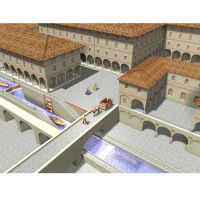
- The ideal city – Ms B Fol 16r and 37v © Leonardo3 - www.leonardo3.net
Man's environment
Between 1484 and 1485, 50,000 people died in Milan of plague. Leonardo had a keen interest in urban renewal and a desire to liberate people from the “infinite evils” of city living. He hated the old fashioned, over-crowded medieval city where people were crammed together “like a herd of goats”.Leonardo proposed new solutions for cities, based on concepts of cleanliness, convenience, the circulation of air and exposure to light. The concept of an ideal city was derived from the Florentine architect/engineer Antonio Filarete, but Leonardo’s vision was more radical.
Leonardo's city was organised on different levels. On the uppermost level, streets that bordered the facades of the palazzi would be for pedestrians only. On the lower level, streets extended behind palazzi at the level of the courtyard, stables and storehouses. These catered for the trafficking of provisions, noisy carts and smelly animals. Interconnecting canals had a hygienic function.
On Ms B Fol 37v the design comprises of a complex series of interconnected levels. Arcades flank the upper streets and the lower streets are connected to the upper via sloping ramps. Open canals are transversed by bridges. All the buildings are well lit and open to air. The whole design is governed by a strict and rigorous geometry, with little concern for green, empty spaces. In Leonardo’s concept, geometrical abstractions take on life and meaning to produce flexible and dynamic solutions for mankind’s predicament.
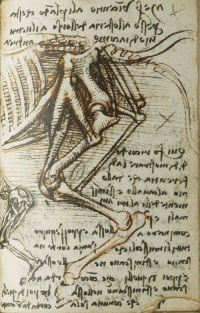
- Ms K Fol 109v - Studies of comparative anatomy. Photo RMN - © René-Gabriel Ojéda
Animals and man
Leonardo was endlessly curious and obviously fond of animals. He was said to have been a vegetarian. In his notebooks he reminded himself to “describe the tongue of the woodpecker and the jaw of the crocodile” and “ the way in which the tail of the fish acts in propelling the fish”. He was particularly interested in the anatomy of animals and their movements, knowledge of which might be applied ultimately for the benefit of mankind.In an endeavour to further his understanding of human anatomy, he regularly dissected the body parts of animals. Animal carcasses were more readily available than human remains. In Ms K Fol109v Leonardo compared the skeletal structure of a man and a horse. In the Study of an embryo within a human uterus with a cow’s placenta, the cotyledons of the placenta are observed from the uterus of a cow, and are added to the human foetus to produce as comprehensive an image as possible of the reproductive system. It is also the first time the foetus was correctly described within the uterus.
With the dream of human flight always in mind, Leonardo scrutinized the bodies of birds and bats. He believed that by copying the structure of their wings, he could successfully build a flying machine (although he changed his mind about this later). The anatomy of the horse was also of the greatest importance. Paintings such as the Adoration of the Magi and the Battle of Anghiari contained numerous horses.
The great Sforza equestrian monument also required knowledge of equestrian anatomy. In the Study of a Horse impeded by the flow of water, Leonardo’s interest in the movement of water and horses are combined to consider the effects of one on the other. The wild expression and straining muscles of the horse wonderfully convey the force of its struggle against the torrential force of the water.
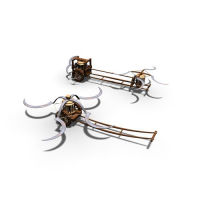
- Scythed chariots - Biblioteca Reale Fol 1030 © Leonardo3 - www.leonardo3.net
Weapons of war and love of life
It may come as a surprise, in light of Leonardo’s evident love of life, that he spent a great deal of effort designing weapons of war. But such inventions were of enormous appeal to wealthy patrons such as Ludovico Sforza, always keen to protect or expand their territory. The Scythed chariot was certainly designed to achieve maximum carnage. Drawn by running horses, it would rapidly charge into battle, its sharp cutting blades revolving and slashing through everything in its wake. Leonardo expresses unease about the destructive power of his machine, noting that such machines “often wreak as much havoc on friends as on foes”.Many years later, he would define war as “beastly madness”. In a prophetic vision of the future, he predicted that, “Animals will be seen on the earth who will always be fighting against each other…and there will be no end to their malice”. He continues by considering the devastating effects of war on the planet,
“By their strong limbs we shall see a great portion of the trees of vast forests laid low throughout the universe…nothing will remain on the earth, or under the earth, or in the waters…O earth, why do you not open and engulf them in the fissures of your vast abyss and caverns, and no longer display in the sight of heaven so cruel and horrible a monster?”
For Leonardo, nothing was more important than life itself. A profound sense of the preciousness of all life and the need for men to live in harmony with each other and their environment are constant themes that run throughout his work.
His extensive study and love of nature seems to have led to a profound sense of mortality, and an acute awareness of the relentless forward march of time, the enemy of life. In a rather poignant passage recounted from Ovid’s metamorphoses, Leonardo laments,
“O time, devourer of all things, and O envious age, you destroy all things and devour all things with the hard teeth of old age, little by little with lingering death. Helen, when looking in a mirror, seeing the shrivelled wrinkles of her face made by old age, wept and contemplated that she had twice been ravished”.




